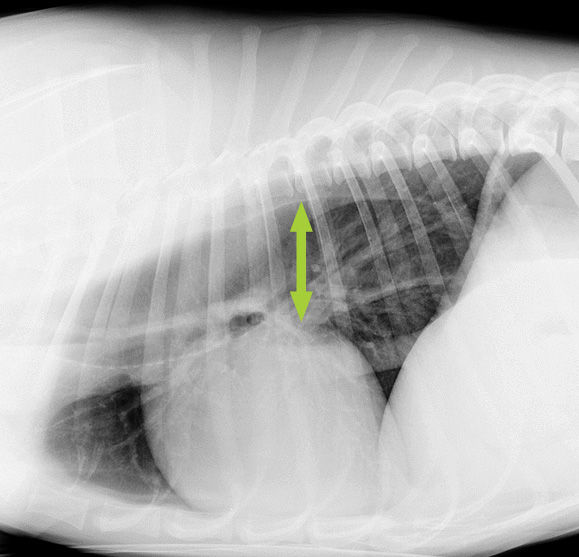
What is megaoesophagus?
The oesophagus is a muscular tube that carries food and water from the back of the throat (the pharynx) down into the stomach. Normally this tube only dilates when food or water is being pushed along it, and otherwise it remains collapsed and empty.
Megaoesophagus refers to a condition where the oesophagus becomes flaccid (floppy), weak and dilated. Food and water is no longer propelled down into the stomach and instead sits in the dilated oesophagus. This condition can occur in both dogs and cats but is much more common in dogs.
What are the signs of megaoesophagus?
Pets with megaoesophagus will regurgitate both food and fluid. This can occur soon after eating or several hours later. It is important to distinguish between regurgitation and vomiting, as some owners may assume their pet is vomiting, when in fact he or she is regurgitating. Regurgitation, which is more commonly seen in cases of megaoesophagus, is a passive process where food or fluid is ejected from the oesophagus through the mouth and this will often occur quite quickly and is not associated with any retching or nausea. Vomiting is less often associated with megaoesophagus and is a more active process than regurgitation. The patient often feels nauseous first and may start to salivate – retching and abdominal contractions then occur, and food or fluid is ejected from the stomach into the oesophagus and then out through the mouth.
Some dogs with megaoesophagus develop a discharge from the nose because regurgitated material passes from the back of the throat into the nose, where it causes irritation. A serious complication which can be seen in association with megaoesophagus is a condition called ‘aspiration pneumonia’. This occurs when a patient regurgitates and then inhales food, fluid or saliva down into the lungs. Depending upon the severity of the problem, patients with aspiration pneumonia will show a variety of signs, ranging from a mild cough through to rapid or laboured breathing – in severe cases the condition can be life-threatening. Some patients may develop aspiration pneumonia as their first obvious sign of megaoesophagus, as they may not have been seen to regurgitate if they generally swallow the regurgitated material.
How is megaoesophagus diagnosed?
Megaoesophagus is diagnosed by taking X-rays (radiographs) of the chest. As sedative drugs or general anaesthesia can cause gas to build up in the oesophagus and mimic the X-ray appearance of a megaoesophagus, it is important that the X-rays are obtained with the patient conscious (i.e. without using sedation or anaesthesia).

Chest x-ray of a dog showing megaoesophagus (the arrow denotes the diameter of the oesophagus)
What causes megaoesophagus?
Some dogs can be born with a megaoesophagus, in which case it is called “congenital”. The breeds most commonly affected by congenital megaoesophagus are Great Danes, German Shepherd Dogs, Labrador Retrievers, Newfoundlands, Chinese Shar Peis and Irish Setters. Megaoesophagus that occurs during adulthood is called ‘acquired’. There are a number of underlying diseases that can cause acquired megaoesophagus, although most commonly no underlying cause is found and the megaoesophagus is then termed ‘idiopathic’. In addition to X-rays, blood tests are often required to look for underlying diseases that might cause megaoesophagus.
How is megaoesophagus treated?
There is no cure for megaoesophagus and no specific treatment is available. If an underlying disease which is causing the megaoesophagus is diagnosed, specific treatment for this disease will generally be prescribed, but in many cases once megaoesophagus has developed, it is a life-long problem. Antibiotics may be prescribed if aspiration pneumonia is present.
Management for megaoesophagus usually involves feeding both food and water from an elevated position and keeping the patient upright in a vertical position during feeding and for several minutes afterwards. A ‘Bailey chair’ is an adapted chair that can be made (similar to a child’s high chair) that the patient can be placed in for feeding.
What is the long term outlook (prognosis)?
Unfortunately, the prognosis for megaoesophagus is generally poor, due to the ongoing risk of aspiration pneumonia and lack of curative treatment for the majority of patients.
If you have any queries or concerns, please do not hesitate to contact us.
Arranging a referral for your pet
If you would like to refer your pet to see one of our Specialists please visit our Arranging a Referral page.